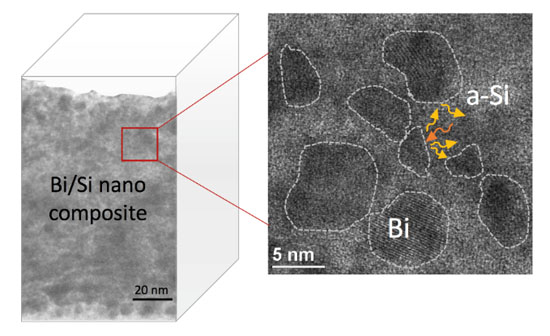Development of an Inorganic Composite Material with the Lowest Thermal Conductivity Using MI
—Study Sets a New Benchmark for Combining Data Science and Experimental Research to Develop Materials—
2018.07.04
National Institute for Materials Sciences
Using materials informatics (MI), the National Institute for Materials Science (NIMS) has succeeded in developing an inorganic composite film material with the lowest thermal conductivity ever recorded.
Abstract
- Using materials informatics (MI), the National Institute for Materials Science (NIMS) has succeeded in developing an inorganic composite film material with the lowest thermal conductivity ever recorded. The procedure, in which promising materials were first predicted using data science and then synthesized experimentally, expedited the discovery of a new, high-performance thermal insulation material. This research demonstrated the effectiveness of MI in materials development and may set a new benchmark for its use.
- Thermal insulation materials have been used to increase energy efficiency across a wide range of applications—in buildings, electronics, power plants and aircraft, to name a few—affecting everything from everyday life to industrial activity. Higher-performance thermal insulation films have been in high demand in recent years to serve various needs, including reducing automobile engine heat loss by applying thermal insulating coatings to combustion chamber walls and pistons. The development of highly effective thermal insulation materials requires an efficient way of identifying optimum material combinations with low thermal conductivity out of a vast number of candidate materials and efficiently synthesizing composites with nanoscale-controlled interfacial structures.
- Using a machine learning technique called regression tree ensembles, the NIMS research team predicted several material combinations with high thermal resistance at the interfaces, in consequently, low thermal conductivity of the composites, out of more than 2,000 possible combinations.One of them, Bi/Si, is selected to be synthesized because of the easiness of the synthesis and the stability of the interface. The team then used a NIMS-developed automatic fabrication system to actually create a set of thin films with the same combination of materials but with different nanostructures. Finally, the team thoroughly examined the correlation between the nanostructural variations and the thermal conductivity of the films. As a result, the team discovered that a structure in which bismuth nanoparticles are scattered in an amorphous silicon matrix exhibits the highest thermal insulation properties (see the figure below). This material demonstrated the lowest thermal conductivity ever recorded (0.16 W/mK) among all inorganic composite film materials previously tested.
- Our novel results demonstrated that the use of MI can substantially expedite efforts to find new functional materials and the development of high-performance materials using existing materials data. In future research, we plan to apply the new technique to the development of a variety of energy-related materials, including thermal insulation materials with even higher performance.
- This research project was carried out by Yibin Xu (Data Platform Director, Center for Materials Research by Information Integration [CMI2], NIMS), Yen-Ju Wu (Postdoctoral Researcher, Thermal Management and Thermoelectric Materials Group [TMTMG], CMI2, NIMS), Michiko Sasaki (Special Researcher, TMTMG, CMI2, NIMS), Fang Lei (Engineer, TMTMG, CMI2, NIMS) and Masahiro Goto (Chief Researcher, Thermoelectric Materials Group, Center for Green Research on Energy and Environmental Materials, NIMS).
This project was conducted as part of the Materials Research by Information Integration Initiative (MI2I) supported by the Japan Science and Technology Agency (JST)’s Support Program for Starting Up Innovation Hub. - This research was published in ACS Applied Nano Materials on July 3, 2018, local time.

TEM cross-section of the Bi/Si composite material with superior thermal insulation properties
Related files
- Research and Services Division of Materials Data and Integrated System (MaDIS)
- Center for Materials Research by Information Integration
Contacts
(Regarding this research)
-
Yibin Xu
Platform Director,
Data Platform
Center for Materials Research by Information Integration
Research and Services Division of Materials Data and Integrated System
National Institute for Materials Science
Tel: +81-29-859-2258
FAX: 029-859-2201
E-Mail: Xu.Yibin=nims.go.jp
(Please change "=" to "@")
(For general inquiries)
-
Public Relations Office
National Institute for Materials Science
1-2-1 Sengen, Tsukuba, Ibaraki 305-0047, Japan
Tel: +81-29-859-2026
Fax: +81-29-859-2017
E-Mail: pressrelease=ml.nims.go.jp
(Please change "=" to "@")
(Regarding the Support Program for Starting Up Innovation Hub)
-
COI Group
Department of Innovation Platform
Japan Science and Technology Agency
E-Mail: ihub=jst.go.jp
(Please change "=" to "@")
Same Keywords
-
Accelerating Thin Film Fabrication Processes Using Machine Learning
(materials informatics,data science)
2020.10.21
-
Demonstrating a Novel Method to Modulate Heat Flow Through the Collective Motion of Spins
(thermal conductivity)
2025.10.06
-
Data Science Approach to Identifying Thermal Conductivity-Related Structural Factors in Amorphous Materials
(thermal conductivity)
2024.01.19
Recent Press Release
-
Simultaneous Imaging of Intracellular DNA and RNA Using Harmless Light
2025.10.27
-
Development of an AI Device Using Ion Gel and Graphene That Dramatically Streamlines Machine Learning Computations
2025.10.14
-
Demonstrating a Novel Method to Modulate Heat Flow Through the Collective Motion of Spins
2025.10.06
